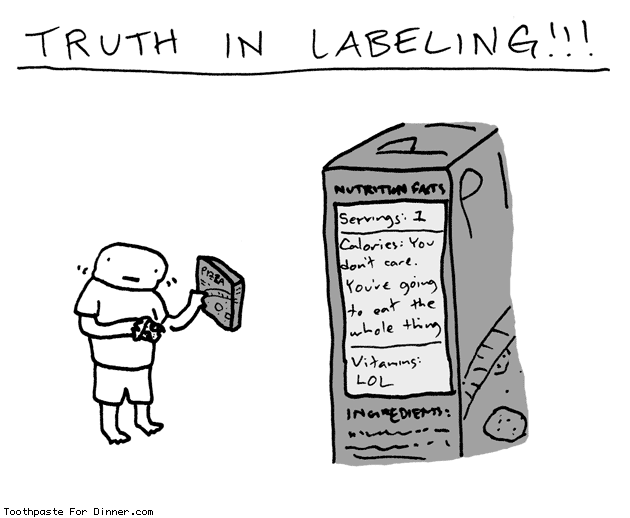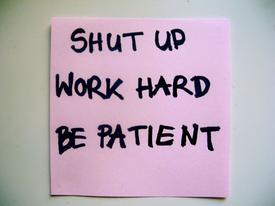We are pleased to announce that on March 4, 2025, an updated Rich Text Editor will be introduced in the MyFitnessPal Community. To learn more about the upcoming changes, please click here. We look forward to sharing this new feature with you!
This is why we can't trust food labels....

therobinator
Posts: 832 Member
I just posted this in my blog, but thought it was certainly worth sharing here as well:
****************************************************
I decided to go over the nutritional information for my Black Bean Brownies, since they were (according to the people I learned the recipe from) supposed to be under 100 calories per brownie, yet they turned out not to be. This is the data that MyFitnessPal gave me (and yes I checked the labels of the branded ingredients to make sure they were accurate before adding them to my recipe):

Do you see the problems that I see?
For the Black Beans: (21 g protein x 4 calories per gram) + (69 grams carbs x 4 calories per gram) + (2 grams fat x 9 calories per gram) = 378 calories....NOT the 315 that the Bush's label would have us believe.
For the Agave Nectar: (0 protein x 4 calories per gram) + (192 grams carbs x 4 calories per gram) + (0 fat x 9 calories per gram) = 768 calories....NOT the 720 that the Madhava label would have us believe.
For the Cocoa -- and this was data provided by the MFP database, not a user-added item: (4 grams protein x 4 calories per gram) + (12 grams carbs x 4 calories per gram) + (3 grams fat x 9 calories per gram) = 91 calories....NOT the 48 that MyFitnessPal would have us believe.
Even the Butter and the Egg Whites are a little off....and, again, these are data provided by MFP (not user-added items).
I just find this all disturbing. I know weight loss, weight gain, and weight maintenance are not exact sciences, and what we should really strive for is to eat the healthiest foods as much of the time as we can, indulge a little here and there, and exercise....but seriously, when just about every ingredient in a recipe is incorrect or somehow not jiving, it gives me pause and concern.
Buyer beware, in all things big and small, I guess.
****************************************************
I decided to go over the nutritional information for my Black Bean Brownies, since they were (according to the people I learned the recipe from) supposed to be under 100 calories per brownie, yet they turned out not to be. This is the data that MyFitnessPal gave me (and yes I checked the labels of the branded ingredients to make sure they were accurate before adding them to my recipe):

Do you see the problems that I see?
For the Black Beans: (21 g protein x 4 calories per gram) + (69 grams carbs x 4 calories per gram) + (2 grams fat x 9 calories per gram) = 378 calories....NOT the 315 that the Bush's label would have us believe.
For the Agave Nectar: (0 protein x 4 calories per gram) + (192 grams carbs x 4 calories per gram) + (0 fat x 9 calories per gram) = 768 calories....NOT the 720 that the Madhava label would have us believe.
For the Cocoa -- and this was data provided by the MFP database, not a user-added item: (4 grams protein x 4 calories per gram) + (12 grams carbs x 4 calories per gram) + (3 grams fat x 9 calories per gram) = 91 calories....NOT the 48 that MyFitnessPal would have us believe.
Even the Butter and the Egg Whites are a little off....and, again, these are data provided by MFP (not user-added items).
I just find this all disturbing. I know weight loss, weight gain, and weight maintenance are not exact sciences, and what we should really strive for is to eat the healthiest foods as much of the time as we can, indulge a little here and there, and exercise....but seriously, when just about every ingredient in a recipe is incorrect or somehow not jiving, it gives me pause and concern.
Buyer beware, in all things big and small, I guess.
0
Replies
-
yes, but keep in mind that some people enter this information wrong, especially the nutrients other than the calories.0
-
I can definitely see your point--and I think it's good to be an informed consumer. I think I have less of a problem with 13 unaccounted for home made calories, than unaccounted for pre-packaged ones. I find that when I weigh my packaged foods, typically there's a little more in the package than it claims. Terrible exacmple...but, the candy bar "Big Hunk", they're supposed to be 85 grams @ 230 calories. Usually it's more like 92 grams...and that means significantly more calories than the package says!
Be careful. Use your food scale...and your brain. If something seems too good to be true calorie-wise, it probably is!0 -
You're learning, through your calculations, why we recommend taking what it says on the label of any prepared food (any combination of items rather than one item) and multiplying it by 1.2 to get closer to the actual caloric content. This is especially true of the foods we eat that are prepackaged (e.g., frozen entrees, etc.) and when we eat out (and use the restaurants' numbers). It's a pretty good general rule of thumb that I try to stick to, after all of the research I've seen has convinced me that it's the simplest and most precise "rule of thumb" for dealing with the issue.
Why couldn't it be that the foods are only 80% of what the label says instead of 120% of what it says? LOL0 -
My original post stated: "yes I checked the labels of the branded ingredients to make sure they were accurate before adding them to my recipe"yes, but keep in mind that some people enter this information wrong, especially the nutrients other than the calories.0 -
This is awful! How is that legal?0
-
I'm so glad I don't have to count calories!!!0
-
Yes, but what I found more disturbing than the packaged foods (because I know legally they can be up to 20% inaccurate) is that MFP database (NON-user added) items are also wrong.You're learning, through your calculations, why we recommend taking what it says on the label of any prepared food (any combination of items rather than one item) and multiplying it by 1.2 to get closer to the actual caloric content. This is especially true of the foods we eat that are prepackaged (e.g., frozen entrees, etc.) and when we eat out (and use the restaurants' numbers). It's a pretty good general rule of thumb that I try to stick to, after all of the research I've seen has convinced me that it's the simplest and most precise "rule of thumb" for dealing with the issue.
Why couldn't it be that the foods are only 80% of what the label says instead of 120% of what it says? LOL0 -
I think if everyone ate the right foods, we'd all be in your boat. Someday.I'm so glad I don't have to count calories!!! 0
0 -
I agree 100%, and that's why I strive (although I certainly don't succees all the time) to eat only whole foods and nothing that comes packaged or processed.I can definitely see your point--and I think it's good to be an informed consumer. I think I have less of a problem with 13 unaccounted for home made calories, than unaccounted for pre-packaged ones. I find that when I weigh my packaged foods, typically there's a little more in the package than it claims. Terrible exacmple...but, the candy bar "Big Hunk", they're supposed to be 85 grams @ 230 calories. Usually it's more like 92 grams...and that means significantly more calories than the package says!
Be careful. Use your food scale...and your brain. If something seems too good to be true calorie-wise, it probably is!0 -
Great observations!!:happy:0
-
i usually try to spare some calories at the end of the day just in case something like that happens.
 0
0 -
I found this explanation online at caloriesperhour.com
"The Numbers Don't Always Add Up
If you check a food label you may find that the total number of calories listed doesn't match the number you arrive at using the 4-9-4 method described above. The reason for the discrepancy may be that the figure for carbohydrates includes insoluble fiber, and the food manufacturer has accounted for this in their figure for calories.
Insoluble fiber passes through your body without being converted to a form that provides energy, or calories. Knowing this, the manufacturer may subtract the caloric value of the insoluble fiber (4 calories per gram) from the total calories figure. When they do this, the 4-9-4 method will give you a higher figure for total calories than the one you find on the food label.
You might think that you could subtract the figure for fiber from the figure for carbohydrates to correct the discrepancy. But the figure for fiber will likely include both soluble and insoluble fiber, and you'd only want to subtract the insoluble fiber. Unfortunately you have no way of knowing how much of the fiber is soluble, and how much is insoluble."
Not sure how that figures for the Brownie recipe, though. :ohwell:0 -
That's an interesting article, kyle4jem. Thank you for adding that.
I still wonder, though, why (aside from simple calculation or data errors) items like Egg Whites and Butter (which have -0- fiber) would not add up.0 -
As said above 1.1/1.2 times is to be safe. I'm pretty sure 100-200 cals isn't going to make much of a difference..trust me I've lost 126 pounds in a year..
Oh my god 2 of the things on that list are from subway and I have subway EVERY day for lunch.. the low fat ones but still..was just almost sick in my mouth!0 -
MFP is wrong on my account all the time ..like it adds cholesterol and other fats to my soy milk and soy products that are not there not even in trivial amounts..sometimes things are wrong. I know if I was eating things that bad for me I would feel crappy. So I never hang my opinions on food labels or my fitness pal and serving sizes are often tiny too and I may eat more then a serving or less and I adjust accordingly0
-
Good info... Need to process this one a bit...0
-
Blogged about this some time ago, and this is what I wrote:
Did you know that by law nutritional labels can be off by as much as 20%? That's right, you could be counting everything and still be eating 20% more than you realize. Restaurant calorie counts? Not even regulated by the FDA. Those same counts also assume that the food is made to recipe standard: an extra bit of butter, oil, cheese, or product substitution can easily add a couple hundred calories. How do you measure your food? If you are not using a scale, this video could be an eye opener for you http://www.youtube.com/watch?v=JVjWPclrWVY
http://www.youtube.com/watch?v=JVjWPclrWVY
As an add on... I just recently revisited this and started weighing fruit, yes fruit. And while most people would think it is harmless, as a woman pushing 50, there is a definite link between sugar intake (REGARDLESS of the source) and my weight loss results. I don't eat a lot of added sugar, so my primary sources are fruit and dairy. My findings? What I considered to be a "medium" peach weighed more than double the "generic" input, and I checked several of them just to be sure that the entry I picked was not a one off. Same goes for what I considered to be a "medium" apple. So I was eating almost double the amount of sugar from fruit that I thought I was. So if you do the math, and I'm off between 20-40 calories per piece of fruit, x 3 or 4 pieces per day, that's anywhere from 120-160 per day...and that can make or break my weight loss. It would put me much closer to maintenance mode caloriewise too.
I used to account for some of this by "rounding" up my entries. I think I need to go back to that method.0 -
As said above 1.1/1.2 times is to be safe. I'm pretty sure 100-200 cals isn't going to make much of a difference..trust me I've lost 126 pounds in a year..
Oh my god 2 of the things on that list are from subway and I have subway EVERY day for lunch.. the low fat ones but still..was just almost sick in my mouth!
That depends....100 extra calories per day over the course of a year is a 10# gain :-)0 -
Food labels can change from one day to the next also. When ever a manufacturer changes anything in their product they have to revise the label. Sometimes it is a matter of change in portion size or container size, or actual weight of the product. In the case of the canned beans it could be....the manufacturer packs the beans less tightly and adds more liquid...same weight, same price, less actual product in the can... same serving size because they include the liquid...more profit for the manufacturer... misleading info on the label...multiple entries in the database, all slightly different for the same product.
In the case of the USDA database, some of those entries are decades old information. What was considered a medium peach 20 years ago would now be considered a small. Farmers have been manipulating growing cycles and cross breeding to produce more hardy and larger produce. Who wants to buy small imperfect peaches when you have all those lovely large plump perfect ones sitting there? (I would grab the smaller ones, they usually smell better too) As has been reported recently, much of our raw produce has lost nutritional value over the years also.
They need to do a serious re-vamp of the nutritional value databases and of the nutritional information available on product labels. Until then, easiest thing to do is to remember that all of the info is just estimates and give yourself some wiggle room for the difference.:ohwell:0 -
Yeah, this is one of the reasons I set my maintenance calorie goal 250 calories less than recommended.0
-
They need to do a serious re-vamp of the nutritional value databases and of the nutritional information available on product labels. Until then, easiest thing to do is to remember that all of the info is just estimates and give yourself some wiggle room for the difference.:ohwell:
This.0 -
i usually try to spare some calories at the end of the day just in case something like that happens.

I do this also - it's a good bet that both calories in and exercise cals out are going to miss the mark a bit.0 -
So i guess that's why not eating my exercise calories is working better for me.
This is so frustrating because I'm super anal retentive and now my perfection bubble has been burst and I'm not sure how to fix it on a daily logging basis. 0
0 -
It's not a justification for not eating back at least a good portion of your exercise calories. That may work for you at first, but eventually it will catch up with you and stop working, even start having a detrimental effect. If you are exercising, and factored that in when you set up MFP, remember that MFP calculates this into your numbers....thus why you need to eat those calories back (your body needs the energy to continue functioning properly and at its most efficient level).So i guess that's why not eating my exercise calories is working better for me.
This is so frustrating because I'm super anal retentive and now my perfection bubble has been burst and I'm not sure how to fix it on a daily logging basis. 0
0 -
i usually try to spare some calories at the end of the day just in case something like that happens.

I do this also - it's a good bet that both calories in and exercise cals out are going to miss the mark a bit.
Yep and yep. And that is why I usually try to stick to a "range" of calories instead of eating my exercise calories. Allows for that wiggle room.0 -
Yep, many things will say 2 servings in the container, but if you measure or weigh the food... I have found 1.6 to 2.2 servings in these "2 serving" containers!!0
-
 0
0
This discussion has been closed.
Categories
- All Categories
- 1.4M Health, Wellness and Goals
- 394.3K Introduce Yourself
- 44K Getting Started
- 259.7K Health and Weight Loss
- 176.1K Food and Nutrition
- 47.3K Recipes
- 232.3K Fitness and Exercise
- 388 Sleep, Mindfulness and Overall Wellness
- 6.4K Goal: Maintaining Weight
- 8.5K Goal: Gaining Weight and Body Building
- 152.7K Motivation and Support
- 7.8K Challenges
- 1.3K Debate Club
- 96.2K Chit-Chat
- 2.5K Fun and Games
- 4K MyFitnessPal Information
- 22 News and Announcements
- 1.2K Feature Suggestions and Ideas
- 2.7K MyFitnessPal Tech Support Questions

















